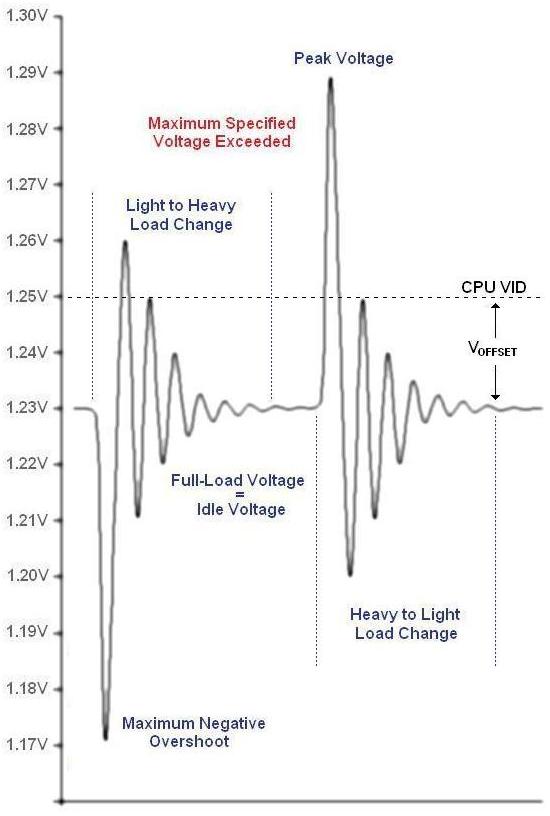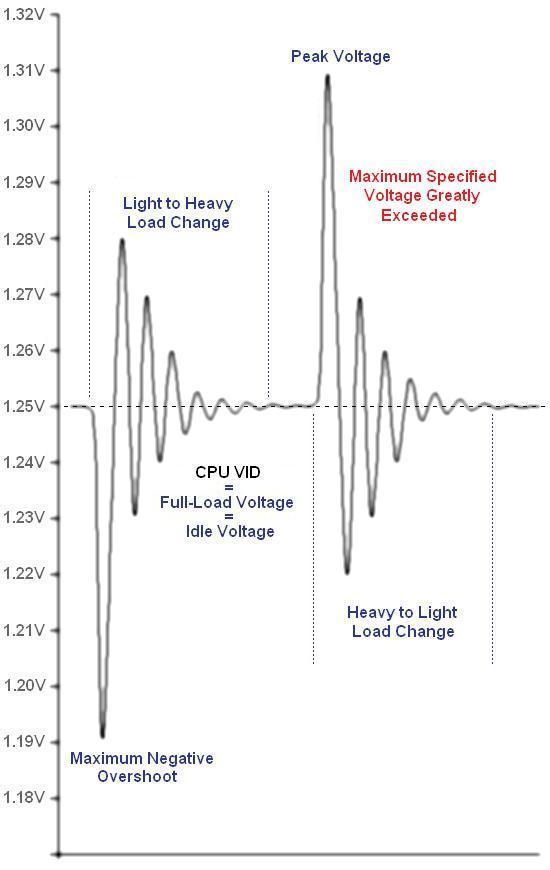Overclocking Intel's New 45nm QX9650: The Rules Have Changed
by Kris Boughton on December 19, 2007 2:00 AM EST- Posted in
- CPUs
Intel Processor Power Delivery Guidelines (Cont'd)
In this next case we eliminate Vdroop altogether and examine the chaos that ensues. As illustrated by our model, removing Vdroop does nothing to reduce the magnitude of the idle to full-load transient but does increase the settling time as the VRM must recover to a higher final regulation voltage. As in the case of no Voffset, it is possible to exceed the maximum allowable CPU voltage (VID). Clearly, removing Vdroop gains us nothing and only serves to create problems that are more serious.

No Vdroop means the VRM circuit must work harder at maintaining a constant voltage
So what happens when we remove both Voffset and Vdroop? The answer is simple - bad things. Although the difference between the maximum positive and negative peak overshoot are the same, severe violations to the CPU VID limit occur. If you're asking yourself what's the problem with this, consider the case of a CPU VID of 1.60000V - because the user feels this is the absolute maximum CPU voltage that they will allow. Just how high do you think CPU voltage will go after leaving a heavy load condition? We can't be sure without knowing more of the details, but we can certainly conclude that it will be well in excess of 1.6V. If you've ever run a benchmark only to have your system crash right as it finishes then you have experienced the consequences of this poor setup.

The user gives up all control over the CPU supply voltage with no Voffset or Vdroop
Finally, let's take one last real-world look at the consequences of removing Vdroop. ASUS' implementation of this feature, labeled as Load Line Calibration and included with their latest line of motherboards, is particularly worthy of our attention for a number of reasons. The first is that setting lower voltages with this option enabled actually results in a condition in which the CPU voltage under load is higher than the idle voltage. Imagine our confusion as we desperately struggle to understand why our system is Prime95 stable for days yet continues to crash under absolutely no load. What's more, in spite of the absence of droop and for reasons unknown, enabling this feature artificially raises our CPU's minimum stable core voltage at 4.0GHz from 1.28V to about 1.33V. As a result, our system uses more power under load than is otherwise necessary. Our efforts to reduce our processor's supply voltage backfired - instead of lowering the system's total power consumption we managed to affect a 20W increase.

Suffice it to say, we found it better to leave Load Line Calibration disabled
With Load Line Calibration disabled in BIOS, setting a CPU Voltage VID of 1.38750 resulted in a no-load voltage of about 1.34V and a full-load value of 1.28V. Enabling this feature and lowering the VID to 1.35000V produced a constant CPU supply voltage, regardless of load (or so it seemed), of 1.33V. Setting a lower VID resulted in a blue screen during Windows boot. Idle voltage was relatively unchanged at about 1.33-1.34V but the full-load voltage required increased by 50mV with no benefit. As you might guess, we recommend you leave this option disabled.
Hopefully we've shown you enough to understand exactly why Voffset and Vdroop are important. Please give second thought to your actions if you're in the habit of defeating these essential system safeguards.










56 Comments
View All Comments
Griswold - Thursday, December 20, 2007 - link
I think the other explanation for the delay is much more likely than this horsecrap.tomoyo - Wednesday, December 19, 2007 - link
This is a great article from both a readability and technical standpoint, I found it very enjoyable to actually read the commentary, which I cannot say is true for 95% of tech reviews. Also the graphs and information presented were extremely useful. I love the demystifying of the vdroop issue to prove that it's a GOOD thing.Amiteriver - Wednesday, December 19, 2007 - link
Finally a review with some understandable explanations of Bios settings and there realation ships. As the motherboards change you get new Bios names for things and your eyes glaze over wondering what the heck some of the terms mean. Look forward to future articles of popular motherboards Bioses. I will be printing this article out. Thanks muchAmiteriver - Wednesday, December 19, 2007 - link
Finally a review with some understandable explanations of Bios settings and there realation ships. As the motherboards change you get new Bios names for things and your eyes glaze over wondering what the heck some of the terms mean. Look forward to future articles of popular motherboards Bioses. I will be printing this article out. Thanks muchSczee - Wednesday, December 19, 2007 - link
Quite possibly the best article on computer hardware I have ever read. I learnt a lot about overclocking from it and plan to put it to use tonight. I'll be looking out for your next piece Kris.Bozo Galora - Wednesday, December 19, 2007 - link
ya, the X48 is being delayed because some top tier mobo manuf needs to get rid of its X38 inventory. My guess is Asus, because they have the muscle to influence Intel. Bleh.So I bought all this super xmas bargain stuff, and now I am going to have to let it gather dust - lol
http://www.digitimes.com/mobos/a20071217PD205.html">http://www.digitimes.com/mobos/a20071217PD205.html
Bozo Galora - Wednesday, December 19, 2007 - link
and the X48 does seem to have a 450-460 cap, at least so farhttp://en.hardspell.com/doc/showcont.asp?news_id=1...">http://en.hardspell.com/doc/showcont.asp?news_id=1...
bryanW1995 - Wednesday, December 19, 2007 - link
Best article I've read here in a long time. Good job.Regs - Wednesday, December 19, 2007 - link
So lets say I have a 65nm Core Duo running between 0.850V-1.3525V. These are the product specs, which I guess .850 is the low limit and 1.325 is the high limit. Why does the voltage have to decrease depending on load? Is it just as simple as "supply and demand"? How does running the CPU at 1.352v run the risk of instability?Aivas47a - Wednesday, December 19, 2007 - link
Great article. You guys have really been distinguishing yourselves with in-depth work on overclocking the last few months: exploring obscure bios settings, tinkering with "extreme" cooling -- keep it up!My experience with a qx9650 so far is very similar to yours: easy scaling to 4 ghz, difficult scaling after that with 4.2 ghz being the practical max for regular operation (folding, etc.).
One issue I will be interested to see you address in the future is fsb overclocking on yorkfield. So far I am seeing yorkfield top out at lower fsb (450-460) than was possible for kentsfield on a comparable P35 or X38 platform. That is not so significant for the unlocked Extreme Edition chips, but could make it difficult to achieve the magic 4 ghz with the q9550 and especially the q9450.